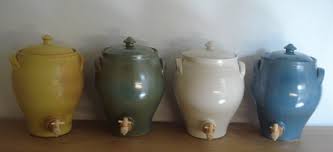The French ‘vin aigre’ means sour wine.
If you let wine alone it sours to vinegar. Unless there is (too much) sulfite in it.
Vinegar is a chemically active solution of 4 to 15% acetic acid.
If the product has less than 4% acetic acid it is called ‘edik’.
According to the New Testament, Jesus on the cross was offered edik as drink in a sponge on a stake. In Israel, vinegar essence (80%) was mixed with water and honey to edik. The Romans called this thirst quencher ’posca’.
 You can basically make vinegar of all alcohol (fermented beverages). Vinegar (white and red), apple cider vinegar, of other fruit or even cereals. The acetic acid bacterium Acetobacter is naturally found in wood. To make vinegar let your liquor seep on wood shavings at 30-35°C.
You can basically make vinegar of all alcohol (fermented beverages). Vinegar (white and red), apple cider vinegar, of other fruit or even cereals. The acetic acid bacterium Acetobacter is naturally found in wood. To make vinegar let your liquor seep on wood shavings at 30-35°C.
Vinegar making you do in the summer. The bacteria multiply by 25 degrees C and convert alcohol into acetic acid. Under the 10⁰C the bacteria do nothing.
Vinegar is a natural product. The bacteria are visible by a skin, the mother (of vinegar), which floats on the surface.
Place the wine dark, not in the sun. Add some vinegar or mother as a starter. The as inoculum mixed mother of vinegar (Acetobacteraceae) ferments the alcohol with oxygen in the air to acetic acid. The mother may not completely air close the liquid, otherwise the process stops.
Dilute alcoholic liquid with water so that the alcohol content is not above 10% and at least 5%. Each percent alcohol produces roughly one percent acetic acid.
Air is needed. If there is too little oxygen, the bacteria die. Open the container regularly and shake a bit.
CH3CH2OH + O2 makes CH3COOH + H2O + 494 kJ
ethanol + oxygen is acetic acid + water + heat
Attention: pottery with glaze may contain lead and lead compounds are toxic.
Tasty herbs for addition to the vinegar: dill, tarragon, basil, chives, lemon balm, etc.
Balsamic vinegar: the traditional balsamic vinegars or ‘naturele’ comes from Modena or Reggio Emilia in Northern Italy. He is based on concentrated grape juice made by long fermentation and matured for years. Balsamic vinegar is a valuable, expensive condiment, at least 12 years old; usually offered in bottles of 1 dl. Most of the in the market available are neither balsamic tradizionale, nor naturel, but usually artificially created imitations.
You can also add garlic to the vinegar. You should first blanch the garlic for a bacterium which is able to sit on the garlic and can proceed a reaction with other substances which are present in the vinegar.
You can use vinegar (with water, herbs) to keep other foods. Onions, pickles, herring,..
Vinegar as cleaning agent is usually made in a synthetic manner, often with methanol and 2 to 3 times more acetic acid.
Verjus (green juice) is a similar medieval flavor based on immature fruit like grapes or apples, gooseberries but also sorrel (and mixtures). Verjus is perishable and tastes sharper than vinegar. The characteristic taste diminishes as the product ages. It is sour, pressed juice (eventually shortly fermented, and with some salt). It is in the kitchen used instead of lemon or vinegar.
Pliny says that the sour grapes should have the size of chickpeas and be picked before the dog days (from 6 July). The unripened grapes were pressed to ferment naturally for several days. The soft old verjuice was mixed with the new sharp verjuice.
